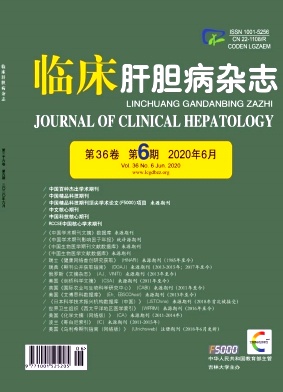|
[1] ZHOU J,ZHOU F,WANG W,et al. Epidemiological features of NAFLD from 1999 to 2018 in China[J]. Hepatology,2020,71(5):1851-1864.
|
|
[2] IP E,FARRELL GC,ROBERTSON G,et al. Central role of PPARalpha-dependent hepatic lipid turnover in dietary steatohepatitis in mice[J]. Hepatology,2003,38(1):123-132.
|
|
[3] HARMON GS,LAM MT,GLASS CK. PPARs and lipid ligands in inflammation and metabolism[J]. Chem Rev,2011,111(10):6321-6340.
|
|
[4] SINGARAVELU R,CHEN R,LYN RK,et al. Hepatitis C virus induced up-regulation of microRNA-27:A novel mechanism for hepatic steatosis[J]. Hepatology,2014,59(1):98-108.
|
|
[5] HACZEYNI F,WANG H,BARN V,et al. The selective peroxisome proliferator-activated receptor-delta agonist seladelpar reverses nonalcoholic steatohepatitis pathology by abrogating lipotoxicity in diabetic obese mice[J]. Hepatol Commun,2017,1(7):663-674.
|
|
[6] RATZIU V,HARRISON SA,FRANCQUE S,et al. Elafibranor,an agonist of the peroxisome proliferator-activated receptor-αand-δ,induces resolution of nonalcoholic steatohepatitis without fibrosis worsening[J]. Gastroenterology,2016,150(5):1147-1159. e5.
|
|
[7] PLOTON M,MAZUY C,GHEERAERT C,et al. The nuclear bile acid receptor FXR is a PKA-and FOXA2-sensitive activator of fasting hepatic gluconeogenesis[J]. J Hepatol,2018,69(5):1099-1109.
|
|
[8] SINAL CJ,TOHKIN M,MIYATA M,et al. Targeted disruption of the nuclear receptor FXR/BAR impairs bile acid and lipid homeostasis[J]. Cell,2000,102(6):731-744.
|
|
[9] CARON S,HUAMAN SAMANEZ C,DEHONDT H,et al. Farnesoid X receptor inhibits the transcriptional activity of carbohydrate response element binding protein in human hepatocytes[J]. Mol Cell Biol,2013,33(11):2202-2211.
|
|
[10] SINGH AB,DONG B,KRAEMER FB,et al. Farnesoid X receptor activation by obeticholic acid elevates liver low-density lipoprotein receptor expression by mRNA stabilization and reduces plasma low-density lipoprotein cholesterol in mice[J]. Arterioscler Thromb Vasc Biol,2018,38(10):2448-2459.
|
|
[11] YOUNOSSI ZM,RATZIU V,LOOMBA R,et al. Obeticholic acid for the treatment of non-alcoholic steatohepatitis:Interim analysis from a multicentre,randomised,placebo-controlled phase 3 trial[J]. Lancet,2019,394(10215):2184-2196.
|
|
[12] TANGIRALA RK,BISCHOFF ED,JOSEPH SB,et al. Identification of macrophage liver X receptors as inhibitors of atherosclerosis[J]. Proc Natl Acad Sci U S A,2002,99(18):11896-11901.
|
|
[13] HEGARTY BD,BOBARD A,HAINAULT I,et al. Distinct roles of insulin and liver X receptor in the induction and cleavage of sterol regulatory element-binding protein-1c[J]. Proc Natl Acad Sci U S A,2005,102(3):791-796.
|
|
[14] RONG X,ALBERT CJ,HONG C,et al. LXRs regulate ER stress and inflammation through dynamic modulation of membrane phospholipid composition[J]. Cel Metab,2013,18(5):685-697.
|
|
[15] ZHOU J,FEBBRAIO M,WADA T,et al. Hepatic fatty acid transporter Cd36 is a common target of LXR,PXR,and PPARgamma in promoting steatosis[J]. Gastroenterology,2008,134(2):556-567.
|
|
[16] HE J,GAO J,XU M,et al. PXR ablation alleviates diet-induced and genetic obesity and insulin resistance in mice[J].Diabetes,2013,62(6):1876-1887.
|
|
[17] HAUGHTON EL,TUCKER SJ,MAREK CJ,et al. Pregnane X receptor activators inhibit human hepatic stel ate cell transdifferentiation in vitro[J]. Gastroenterology,2006,131(1):194-209.
|
|
[18] REDDY AB,MAYWOOD ES,KARP NA,et al. Glucocorticoid signaling synchronizes the liver circadian transcriptome[J].Hepatology,2007,45(6):1478-1488.
|
|
[19] MARINO JS,STECHSCHULTE LA,STEC DE,et al. Glucocorticoid receptorβinduces hepatic steatosis by augmenting inflammation and inhibition of the peroxisome proliferator-activated receptor(PPAR)α[J]. J Biol Chem,2016,291(50):25776-25788.
|
|
[20] PATEL R,PATEL M,TSAI R,et al. LXRβis required for glucocorticoid-induced hyperglycemia and hepatosteatosis in mice[J]. J Clin Invest,2011,121(1):431-441.
|
|
[21] WANG Y,VISCARRA J,KIM SJ,et al. Transcriptional regulation of hepatic lipogenesis[J]. Nat Rev Mol Cell Biol,2015,16(11):678-689.
|
|
[22] le MARTELOT G,CLAUDEL T,GATFIELD D,et al. REV-ERBalpha participates in circadian SREBP signaling and bile acid homeostasis[J]. PLo S Biol,2009,7(9):e1000181.
|
|
[23] KIM EJ,YOON YS,HONG S,et al. Retinoic acid receptor-related orphan receptorα-induced activation of adenosine monophosphate-activated protein kinase results in attenuation of hepatic steatosis[J]. Hepatology,2012,55(5):1379-1388.
|
|
[24] YANG JD,ABDELMALEK MF,PANG H,et al. Gender and menopause impact severity of fibrosis among patients with nonalcoholic steatohepatitis[J]. Hepatology,2014,59(4):1406-1414.
|
|
[25] CHOW JD,JONES ME,PRELLE K,et al. A selective estrogen receptorαagonist ameliorates hepatic steatosis in the male aromatase knockout mouse[J]. J Endocrinol,2011,210(3):323-334.
|
|
[26] GROSSMANN M,WIERMAN ME,ANGUS P,et al. Reproductive endocrinology of nonalcoholic fatty liver disease[J]. Endocr Rev,2019,40(2):417-446.
|







 DownLoad:
DownLoad: